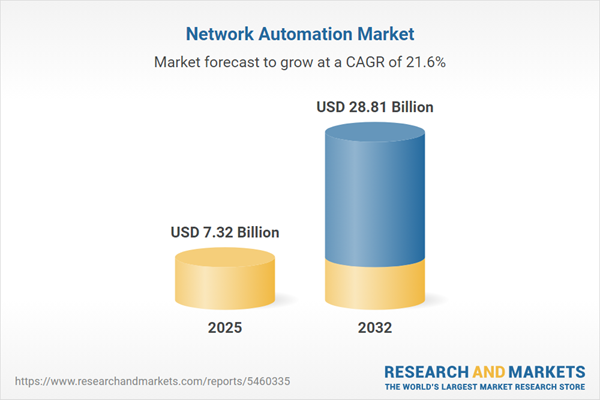Speak directly to the analyst to clarify any post sales queries you may have.
Network automation is transforming enterprise IT by empowering executives to achieve greater operational agility, efficiency, and alignment. With digital infrastructures growing more complex, automated solutions provide a strategic response—enabling organizations to overcome internal bottlenecks and maintain visibility in fast-changing business environments.
Market Snapshot: Global Network Automation Market Size and Growth
The global network automation market shows robust momentum, increasing from USD 6.04 billion in 2024 to USD 7.32 billion in 2025, with expectations to reach USD 28.81 billion by 2032. This trajectory reflects a strong compound annual growth rate (CAGR) of 21.56%.
Increased data volumes, greater network complexity, and heightened demand for enterprise automation are primary factors driving expansion. Automated networks are helping organizations improve resource allocation, refine infrastructure management, and respond quickly to evolving operational and regulatory expectations while safeguarding continuity across critical sectors.Scope & Segmentation: Network Automation Market Analysis
- Component: Managed services, professional service providers, and automation platforms help organizations modernize legacy systems and ease the transition toward advanced IT environments.
- Deployment Model: Cloud-based, hybrid, and on-premises network automation solutions give IT teams flexibility to adapt infrastructure strategies for modernization and better alignment with emerging technology cycles.
- Organization Size: Scalable network automation solutions support both large enterprises and small to mid-sized businesses, ensuring seamless adoption regardless of business scale or technology maturity.
- Technology: Tools leveraging artificial intelligence, machine learning, advanced analytics, SD-WAN, software-defined networking, virtualization, and network visualization foster process precision and enable informed decision-making.
- Application: Solutions address configuration management, orchestration, provisioning, performance testing, security, compliance, and network visualization, supporting robust operations in varied enterprise scenarios.
- Vertical: Key sectors such as banking, insurance, energy, government, healthcare, IT, telecommunications, manufacturing, retail, transportation, utilities, and logistics deploy automation to achieve regulatory compliance and optimize sector-specific processes.
- Region: The Americas, Europe, Middle East, Africa, and Asia-Pacific exhibit different regulatory environments and investment trends, shaping how enterprises deploy automation to meet local operational and compliance requirements.
- Companies: Leading industry participants—including Cisco Systems, Juniper Networks, Hewlett Packard Enterprise, IBM, VMware, Ciena Corporation, Nokia, Arista Networks, Extreme Networks, and Infoblox—set technical standards and influence the market’s evolution.
Key Takeaways for Senior Decision-Makers
- Enterprise-wide automation brings unified infrastructure visibility, helping leaders align IT objectives with core business strategies while maintaining operational transparency.
- Standardized and automated processes streamline governance and simplify complexity in hybrid and multi-cloud environments, supporting risk reduction and consistent operations.
- Integrated workflows within automation enhance network security and resilience, freeing IT teams to prioritize innovation over routine maintenance.
- Collaboration between technology, business, and security stakeholders supports effective governance, digital transformation, and strict adherence to dynamic regulatory frameworks.
- Intent-based networking and digital twins contribute to scalable automation solutions, improving outcome predictability as operations shift.
- Automated regulatory documentation processes are critical in heavily regulated sectors, minimizing manual effort and supporting faster compliance audits.
Tariff Impact: Policy Shifts Shaping 2025 Strategies
Planned changes to U.S. tariffs on network automation hardware and related components are influencing procurement decisions among enterprises. Senior executives are now prioritizing nearshore supply chains, automating procurement steps, and staggering infrastructure investments to ensure long-term project continuity during policy transitions.
Methodology & Data Sources
This report combines insights from direct interviews with IT decision-makers, analysis of credible secondary market sources, and rigorous reviews of industry regulatory frameworks. Through triangulation and scenario planning, it offers actionable and objective guidance for approaching network automation investments and challenges.
Why This Report Matters
- Detailed segmentation and expert analysis help executives benchmark current strategies, recognize regional innovation dynamics, and pinpoint emerging market factors that could influence business priorities.
- Evidence-based recommendations support risk mitigation, operational excellence, and facilitate swift adaptation to changing compliance and technological standards.
- Objective findings enable informed planning for automation investments designed to sustain organizational growth over the long term.
Conclusion
Network automation stands as a strategic enabler for enterprise resilience and responsive business operations. Senior leaders who leverage these solutions are better positioned to optimize processes and steer their organizations through continual market and regulatory change.
Additional Product Information:
- Purchase of this report includes 1 year online access with quarterly updates.
- This report can be updated on request. Please contact our Customer Experience team using the Ask a Question widget on our website.
Table of Contents
3. Executive Summary
4. Market Overview
7. Cumulative Impact of Artificial Intelligence 2025
Companies Mentioned
The companies profiled in this Network Automation market report include:- Cisco Systems, Inc.
- Juniper Networks, Inc.
- Hewlett Packard Enterprise Company
- International Business Machines Corporation
- VMware, Inc.
- Ciena Corporation
- Nokia Corporation
- Arista Networks, Inc.
- Extreme Networks, Inc.
- Infoblox, Inc.
Table Information
| Report Attribute | Details |
|---|---|
| No. of Pages | 189 |
| Published | November 2025 |
| Forecast Period | 2025 - 2032 |
| Estimated Market Value ( USD | $ 7.32 Billion |
| Forecasted Market Value ( USD | $ 28.81 Billion |
| Compound Annual Growth Rate | 21.5% |
| Regions Covered | Global |
| No. of Companies Mentioned | 11 |









